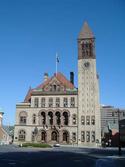According to the 2011 census, the London commuter shed --- defined here as the of London (the Greater London Authority, or GLA) and the East and Southeast regions of England --- had a 2013 population of 23.2 million, spread over an area of 15,400 square miles (39,800 square kilometers). read more »
Urban Issues
Australia’s Recipe for Urban Decay
Across federal, state, and local levels, Australian urban planning authorities have emphasized the need for policies that seek to limit urban fringe development and create densely-populated urban centers. This process is called ‘urban consolidation’ and has been a goal of Australian authorities for more than three decades. More specifically, urban consolidation is defined by efforts to concentrate housing, jobs, and amenities around “activity centers” such as a traditional downtown, satellite urban centers, and elongated strategic corridors. read more »
- Login to post comments
Hooray For the High Bridge
My latest article is online in City Journal and is a look at the restoration and reopening of the High Bridge in New York City. Part of the original Croton Aqueduct system that first brought plentiful clean water to New York, portions of the High Bridge are the oldest standing bridge in the city. Here’s an excerpt: read more »
Havana, Cuba–Stagnation Doesn’t Preserve Cities, Nor Does Wealth Destroy Them
Before taking my trip to Havana, one thing that I was curious about was how a half-century of Communism had affected the built fabric. While there are obvious disadvantages to economic stagnation, I figured that it would have at least created a charming-looking city. There are, after all, a handful of U.S. cities, and numerous European ones, that have resisted growth, modernization, and the automobile, only to remain quaint and historic. read more »
- Login to post comments
Havana, Cuba–The City Of Scarcity
1. I’m now a week removed from my Cuba trip, where I spent 4 days in Havana biking through the city’s near-hourly mix of high heat and torrential rainfall, returning to my bed & breakfast each night covered in soot. read more »
- Login to post comments
Commuting in New York
The New York commuter shed (combined statistical area) is the largest in the United States, with 23.6 million residents spread across 13,900 square miles in New York, New Jersey, Connecticut and Pennsylvania. It includes 35 counties, in eight metropolitan areas, including New York (NY-NJ-PA), Allentown-Bethlehem (PA-NJ), Bridgeport-Stamford (CT), East Stroudsburg (PA), Kingston (NY), New Haven (CT), Torrington (CT) and Trenton (NJ). read more »
- Login to post comments
A Selectively Golden State Jobs Outlook
Every year, I, along with Pepperdine’s Michael Shires, have what has become the often-dispiriting job – for a 40-year California resident – of evaluating the nation’s metropolitan regions in terms of both short-term and midterm job growth. Yet, this year, the results for our state’s metros are somewhat improved, as California’s post-recession job-growth rate now equals, and could surpass, the still-somewhat insipid national average.
After years of subpar growth, California is reaping the advantages of a fortuitous economic alignment of ultralow interest rates, high stock values and growing investments in high-end residential real estate. Vast sums are pouring into the state for new tech ventures, speculative hotel and residential developments. read more »
- Login to post comments
America's Largest Commuter Sheds (CBSAs)
Core Based Statistical Area (CBSA) is the Office of Management and Budget’s (OMB) way of defining metropolitan regions. The OMB (not the Census Bureau) defines criteria for delineating its three metropolitan concepts, combined statistical areas, metropolitan statistical areas, and micropolitan statistical areas. The CBSA has obtained little use since this adoption for the 2000 census. According to OMB: read more »
- Login to post comments
Stack and Pack vs. Smear All Over
I drove out to a distant suburb recently to attend to some business and I passed by a cluster of billboards on the side of the freeway that got me thinking. The general gist of the slogans asserted a conservative anti-government anti-urban rebellion. These are clearly people who don’t want density and public transit imposed on them by pointy headed liberal idiots. I have to admit I have some sympathy for this perspective, although probably not for the same reasons as the billboard people. read more »
The Cities Winning The Battle For Information Jobs 2015
We are supposed to be moving rapidly into the “information era,” but the future, as science fiction author William Gibson suggested, is not “evenly distributed.” For most of the U.S., the boomlet in software, Internet publishing, search and other “disruptive” cyber companies has hardly been a windfall in terms of employment. read more »
- Login to post comments




















